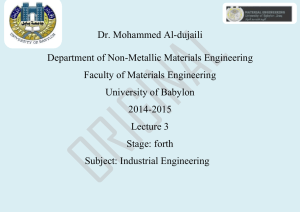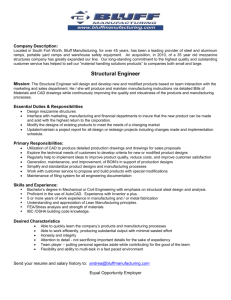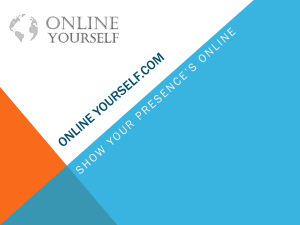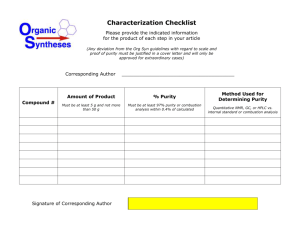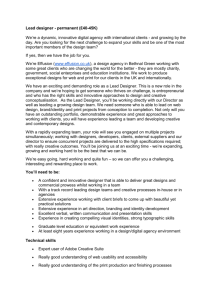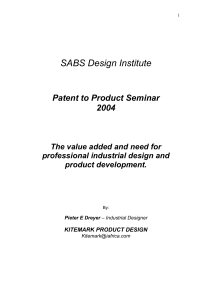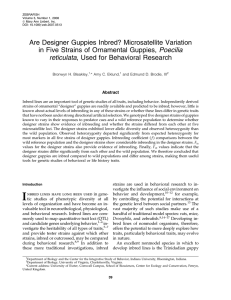Raw materials testing
advertisement
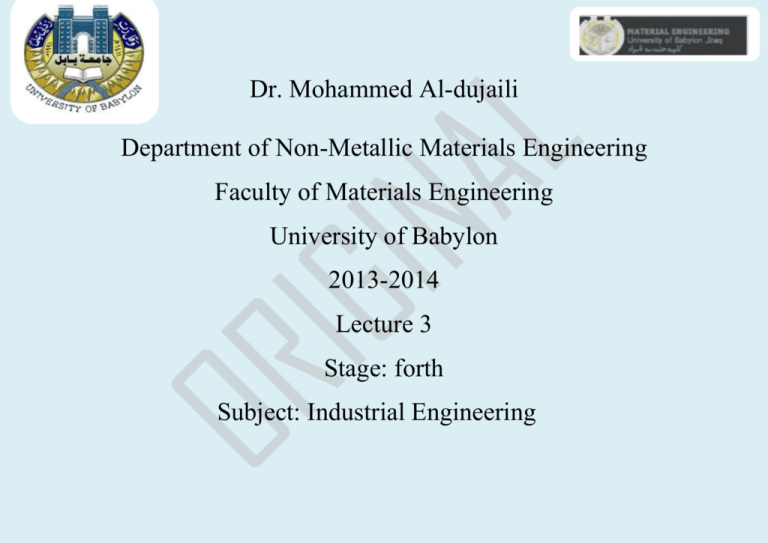
Dr. Mohammed Al-dujaili Department of Non-Metallic Materials Engineering Faculty of Materials Engineering University of Babylon 2013-2014 Lecture 3 Stage: forth Subject: Industrial Engineering Detailed Steps for Product Design, Translate Specification Product, Raw Material Tests Overview Detailed design is such a fundamental necessity to manufacturers that it exists at the intersection of many product development processes. And given this broad influence, as well as the impact of prevailing industry dynamics such as distributed product development, shortening product development lifecycles and increased product complexity, companies are feeling immense pressure to improve their detailed design process. Definition of Detailed Design As a core engineering process, detailed design transforms concept alternatives, preliminary physical architectures, design specifications, and technical requirements into final, cross-disciplinary design definitions. These designs are further refined and all accompanying documentation required for manufacturing is completed in order for timely delivery to the customer of a fully defined, complete product. Or Developing a completely defined product design that is fully documented for manufacturing in managing global design, the top priority action to standardize processes. Global design extends the challenges of control, communication and collaboration. Best-in-class companies were four times more likely to employ centralized product data and automated processes. the diagram explains process of fully defining product design that meets requirements and is sufficiently documented for manufacturing. Understanding the Need for Detailed Design Detailed design provides the link for integrating all cross-disciplinary conceptual and preliminary data into a complete, finished digital product definition. Accordingly, today’s detailed design process is characterized by highly sophisticated designs and an ever-increasing demand for data sharing. Since many companies operate in a distributed environment, among partners and design teams, and across time-zones and language barriers, fast, secure information access is essential. It’s an absolute necessity to ensure that everyone is working on the correct version of the data while tracking team decisions and having real-time visibility into the team’s progress. Along the way, engineers must continually manage change and design complexity. They need to assess risks and balance trade-offs while rapidly delivering high quality designs that work reliably and offer customers value. Given the prevalence of electrical content in the majority of today’s products, it is necessary to effectively handle concurrent design of interrelated components, and improve collaboration between all different design disciplines (electrical, mechanical, software). Changes to requirements are frequent, and incorporating those changes into the design process in a managed and controlled way is vital. Balancing changing requirements with cost and quality pressures further complicates matters. And, ever-shrinking product lifecycles place a premium on an organization’s ability to implement automation and design reuse. Benefits of an Optimized Process for Detailed Design An optimized, formalized, and flexible detailed design process enables companies to rapidly deliver competitive, high quality designs that offer customers real value. Typical benefits of improving the detailed design process may include: Improve Design Productivity • Centrally control and manage all design data (mechanical, electrical, software, documents) • Enable concurrent design of interrelated components • Easily and effectively drive design to meet key requirements • Further automate and streamline the generation of deliverables (e.g., assemblies, drawings, manufacturing process plans) Increase Design Process Efficiency • Enable a formalized, automated, and repeatable design processes • Ensure everyone is working on the correct version of the product data • Enable “what if” design investigations, either with or without formal data management • Improve project execution and visibility into team progress Optimize Design Reuse • Reduce design cost by supporting part reuse and eliminating component duplication • Improve ability to quickly and easily find appropriately classified designs Improve Design Collaboration • Manage global product development involving external suppliers and customers • Provide for secure distributed team and customer design collaboration • Safely share cross-discipline product data across a globally dispersed enterprise product development team • Encourage early and frequent cross-discipline communication; visualize heterogeneous design data.. Detailed steps for product design Product design can be broken into 7 steps, and as follows; 1. Problem Assessment It is a good idea to write down what the problem is first. Don't write down the solution to the problem at this point, even if the company know how to do so. The company simply need to state what the problem is and nothing more. I have seen the development of new products become complicated and time consuming simply because the problem was never written down. A proper statement of the problem helps keep everyone on the same page and works to eliminate project creep. 2. Design Specification This is the step in which a solution to the previously defined problem begins to form. At this point a list of requirements of everything the company can think of should be written down. The company is not coming up with a solution just yet only setting the requirements necessary to create the product. Some examples of what should be on its list include, a retail price (how much are people whiling to pay for this), size of the object (does it need to fit into someone's hand or through a door or in a garage), how fast should it go, does it need to be water proof, what should it be made of, does it use batteries or plug into the wall. This list can go on and on but the important thing is that the company list what is important to company. This list will help company and its designer in the next step. 3.Idea Generation Now the company is getting somewhere, the problem has been defined and requirements have been set. At this point the company should brainstorm and sketch out company ideas. Don't worry if the drawings are not pretty, the company is only trying to see if the concepts could work or if there is an obvious flaw. If the company is not mechanically inclined, the company may want to find someone who specializes in product or industrial design to help. Many design companies have no problem meeting with the company to discuss and sketch a few ideas before company will be under any obligation to sign a contract or pay anything. The company will want to come up with one or two good ideas before moving to the next step. 4.Concept Design Once at least one good idea for the new product has been sketched the company will want to have the design worked out in a little more detail. The designer will come up with a basic 3d design on a computer that is detailed enough to be sure the idea will work but not so detailed that it takes more than just a few hours to complete. This is the last step where an idea is either given the green light or trashed. 5.Detailed Design Now that a solid concept design has been created its time to get down to the details. In this phase the designer will create full detail 3d virtual models of all parts, work out design problems, create assembly and part drawings for every part, find suppliers for all purchased components and create 3d physical prototypes if necessary. This phase is complete when all problems have been solved and a full set of drawings have been delivered 6. Testing Testing is a very important part of product design and should not be overlooked. This step can be as simple as having a few people use the product for feed back or as complicated as sending it to a testing laboratory for a thorough testing by professionals. The level of testing will most likely be determined by requirements of any retail stores that will be selling the product. It is important that the company has some companies test the product which have not been involved in the design process. Some companies who have not been part of the design will give a less biased opinion plus company can watch for any difficulty they may have using the product. 7. Manufacturing The final step in the design process is manufacturing, in this step the company or the designer will find suitable manufacturing facilities to create the product. The company will need to come up with an agreement with the manufacturer on the terms of what they will be providing, the cost and when it will be delivered. So what factors might a designer have to consider in order to eliminate iteration? Manufacture - Can the product be made with our facilities? Sales - Are we producing a product that the customer wants? Purchasing- Are the parts specified in stock, or do why have to order them? Cost - Is the design going to cost too much to make? Transport-Is the product the right size for the method of transporting? Disposal - How will the product be disposed at the end of its life? The Detail Design Process Translate Specification Product To design a product well, a design teams needs to know what it is they are designing, and what the end-users will expect from it. Quality Function Deployment is a systematic approach to design based on a close awareness of customer desires, coupled with the integration of corporate functional groups. It consists in translating customer desires (for example, the ease of writing for a pen) into design characteristics (pen ink viscosity, pressure on ball-point) for each stage of the product development. Stages of the product development Ultimately the goal of QFD is to translate often subjective quality criteria into objective ones that can be quantified and measured and which can then be used to design and manufacture the product. Design and manufacture the product It is a complimentary method for determining how and where priorities are to be assigned in product development. The intent is to employ objective procedures in increasing detail throughout the development of the product. The 3 main goals in implementing QFD are: 1. Prioritize spoken and unspoken customer wants and needs. 2. Translate these needs into technical characteristics and specifications. 3. Build and deliver a quality product or service by focusing everybody toward customer satisfaction. Since its introduction, Quality Function Deployment has helped to transform the way many companies: • Plan new products • Design product requirements • Determine process characteristics • Control the manufacturing process • Document already existing product specifications. Raw material testing and quality control. Our raw material testing laboratory provides purity, contamination, and material testing services, for a variety of raw materials. Raw material quality control is important to prevent product failure and ensure a consistent level of quality, as well as safety in consumer and industrial products. Occasional testing of this type will help keep up the company reputation for fine products and save costs by helping to prevent product recalls. From polymers, plastics, rubbers, metals, powders, gels, dyes, and other commonly used raw materials, whenever a manufacturer switches suppliers they should have an independent testing laboratory test the quality of the ingredients. This will verify the materials are at the level of quality the manufacturer is paying their supplier for, and that no contaminates are finding their way into the materials. Therefore, tests raw materials, feedstocks and other commodities, ingredients and components used in a wide range of products. Testing raw materials can include evaluation and screening of feedstocks, unprocessed materials, semi-processed materials and finished products for quality specifications, impurities and more, including higher-end analytical testing and characterization if required. Raw materials testing: A. B. C. D. E. Quality Control Laboratory Materials Analysis and Testing Cargo Inspection Services Crude Oil and Petroleum Feedstock's Tests Polymer and Plastics Analysis F. G. H. Biofuels Testing and Inspection Petro-chemicals Testing Elemental Analysis and Trace Metals Accordingly, scientists provide a variety of raw material quality control testing services including; 1) Material Analysis: materials testing laboratory analyzes samples of all classes for identification, purity, properties, impurities, and more. The objective of material characterization is often to understand the chemistry of the major and minor components in a substance. 1. Manufacturing Product Failure cases, an unknown contaminant is usually the main cause of the failure. 2. Chemical Product Development cases, identify components of a competing product or discontinued raw material testing. 2) Product Failure Analysis; Failure analysis laboratory can help identify the cause, develop a solution, and prevent future product failure which can be extremely costly for works in terms of production costs, time delays. 3) Quality Control Testing Quality control laboratory will helps ensure products are safe and effective throughout the manufacturing process to the finished product. the method development and method validation developments programs for early or late-stage product. 4) Material Purity Testing Need to test for impurities? purity testing laboratory which specializes in material analysis of contaminants, testing impurities, determine residuals that may be left behind, and test for degradation over time. Material Behavior Assumptions There is a very wide range of materials used for structures, with drastically different behavior. In addition the same material can go through different response regimes: elastic, plastic, viscoelastic, cracking and localization, fracture. As noted above, we will restrict our attention to a very specific material class and response regime by making the following behavioral assumptions. 1. Macroscopic Model. The material is mathematically modeled as a continuum body. Features at the meso, micro and nano levels: crystal grains, molecules, and atoms, are ignored. 2. Elasticity. This means the stress-strain response is reversible and consequently the material has a preferred natural state. This state is assumed to be taken in the absence of loads at a reference temperature. By convention we will say that the material is then unstressed and undeformed. On applying loads, and possibly temperature changes, the material develops nonzero stresses and strains, and moves to occupy a deformed configuration. 3. Linearity. The relationship between strains and stresses is linear. Doubling stresses doubles strains, and viceversa. 4. Isotropy. The properties of the material are independent of direction. This is a good assumption for materials such as metals, concrete, plastics, etc. It is not adequate for heterogenous mixtures such as composites or reinforced concrete, which are anisotropic by nature. The substantial complications introduced by anisotropic behavior justifies its exclusion from an introductory treatment. 5. Small Strains. Deformations are considered so small that changes of geometry are neglected as the loads are applied. Violation of this assumption requires the introduction of nonlinear relations between displacements and strains. This is necessary for highly deformable materials such as rubber (more generally, polymers). Inclusion of nonlinear behavior significantly complicates the constitutive equations and is therefore left for advanced courses. Typical tension test behavior of mild steel, which displays a well defined yield point and extensive yield region. Three material response “flavors” as displayed in a tension test Different steel grades have approximately the same elastic modulus, but very different post-elastic behavior
